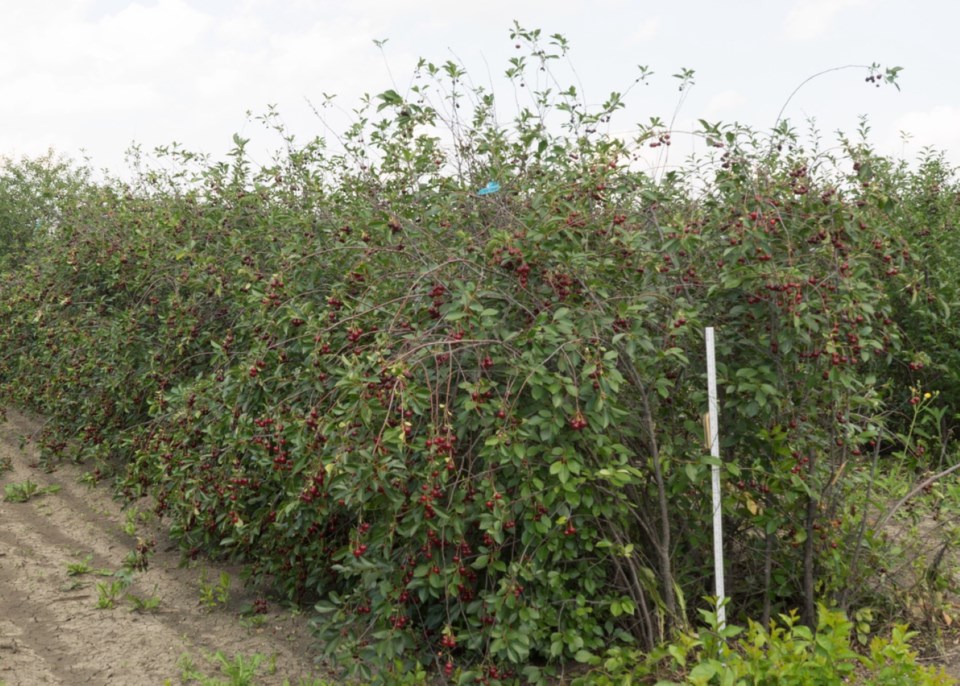Some more things to consider to increase winter survival.
Overly fertile soil may inspire plants to keep growing. I recall a grower telling me that her cherries were growing more than a meter every year and dying back each winter. That sounded like way too much growth and dieback. She investigated the history of her farm and found that the small hills where she had planted the cherries had been manure piles from a huge cattle operation decades earlier. She went to the extreme of planting corn for a couple seasons which used up a lot of the nitrogen and then her cherries grew less each year but no longer experienced died back.
One of the general principles I often tell fruit gardeners is to have bare ground around their fruit plants of at least a meter in each direction. That is good advice except where soil fertility is very high. At the university, when we seeded grass at the same time as planting cherries, those shrubs only grew a metre tall after 10 years. But cherries planted in bare soil that was kept weed-free grew two meters tall in four years and produced lots of fruit.
We had a completely different experience when we planted a demonstration orchard at the former Ursuline school in Bruno. The orchard site was where nuns had grown vegetables for decades, religiously adding compost and manure every season.
Some short plants can survive winter only if well insulated by either snow or straw. Most notable in this regard are strawberries. In Saskatchewan, we usually have dependable snow cover. It's been so dependable that most years professional strawberry growers don't even bother to cover their plants with straw. However, if you get into the --30s with no snow cover, most strawberries will die. Researchers were able to easily overwinter California strawberry varieties as long as they applied the straw in the fall before very cold temperatures arrived. With strawberries, you want to apply the straw just as the ground begins to freeze. If you apply it too early when it's warm, heat could be retained under the straw which may rot the plants. In the spring, you want to remove the straw once the plant starts to grow. If you leave the straw on too long, rotting may occur. But if you take it off too soon, cold damage can occur. The straw layer should be about three inches.
If a plant can be grown as a shrub or a tree, grow it as a shrub and it will have greater hardiness. Occasionally, people have trained shrubs such as roses, hydrangeas, cherries, haskap and others to a single trunk. If one has rodent problems and plants have only a single trunk that gets chewed, the entire plant can be destroyed. But if a shrub has a dozen stems the chances are good that maybe the rodents won't damage all of them. Also, multiple trunks can catch snow better and provide greater insulation to the roots from the cold. Particularly with fruit bushes, trunks may only have a productive life of a decade or so and then decline. By having multiple trunks, one can remove the older ones as they cease good production and plants can continue being productive for decades.
A challenge for the future will be the effect of warmer winters. Prairie-adapted plants are used to having long cold winters. They go into deep dormancy, but when it warms up, they start growing immediately. If winters have warm spells in the middle, like when chinooks happen, some plants may wake up and become damaged from the cold. It will be a challenge for plant breeders and nurseries to keep supplying hardy worthwhile varieties. If you are really into a specific species of plant or plants, it may be worthwhile to investigate on the internet where the plant comes from. Was it bred in a similar climate to yours? Does the nursery you are buying from test varieties before selling them? One of the best things to be is a nosey gardener. Talk to neighbours and ask where they got those beautiful plants and find out the variety names.
Bob Bors is co-author of 'Growing Fruit in Northern Gardens'.
This column is provided courtesy of the Saskatchewan Perennial Society (SPS; [email protected]). Check out our website (www.saskperennial.ca) or Facebook page (www.facebook.com/saskperennial).




